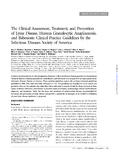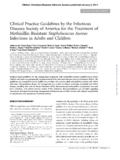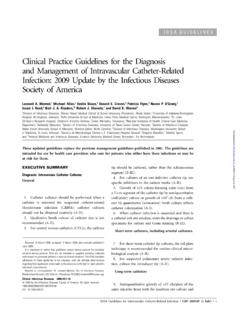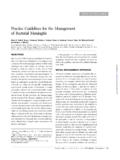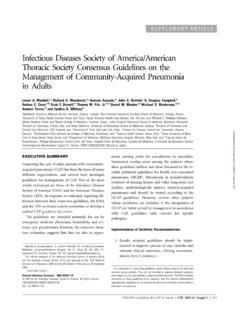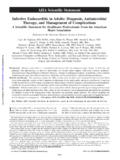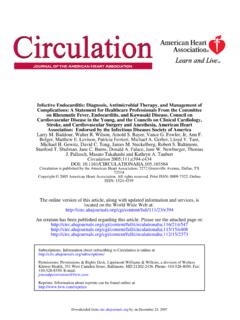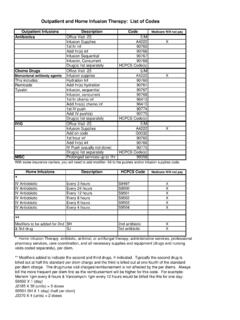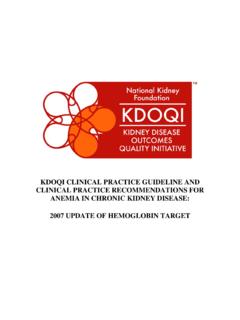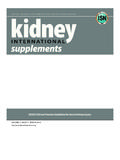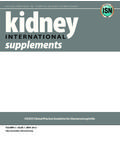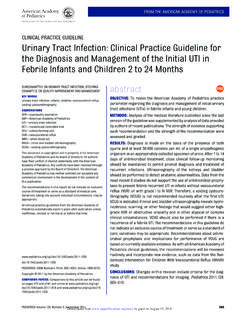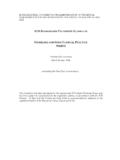Transcription of Clinical Practice Guideline for the Diagnosis and ...
1 IDSA GUIDELINESC linical Practice Guideline for the Diagnosisand Management of Group A StreptococcalPharyngitis: 2012 Update by the InfectiousDiseases Society of AmericaaStanford T. Shulman,1 Alan L. Bisno,2 Herbert W. Clegg,3 Michael A. Gerber,4 Edward L. Kaplan,5 Grace Lee,6 Judith M. Martin,7and Chris Van Beneden81 Department of Pediatrics, Division of Infectious Diseases, Ann & Robert H. Lurie Children s Hospital, Northwestern University Feinberg School ofMedicine, Chicago, Illinois;2 Department of Medicine, University of Miami Miller School of Medicine, Miami Veterans Affairs Healthcare System,Miami, Florida;3 Department of Pediatrics, Hemby Children s Hospital and Eastover Pediatrics, Charlotte, North Carolina;4 Department of Pediatrics,Cincinnati Children s Hospital Medical Center, Cincinnati, Ohio;5 Department of Pediatrics, University of Minnesota Medical School, Minneapolis,Minnesota;6 Division of Infectious Diseases, Boston Children s Hospital, Boston, Massachusetts;7 Department of Pediatrics, University of Pittsburgh,Pittsburgh, Pennsylvania.
2 And8 Respiratory Diseases Branch, National Center for Immunization and Respiratory Diseases, Centers for Disease Controland Prevention, Atlanta, GeorgiaThe Guideline is intended for use by healthcare providers who care for adult and pediatric patients withgroup A streptococcal pharyngitis. The Guideline updates the 2002 Infectious Diseases Society of Americaguideline and discusses Diagnosis and management, and recommendations are provided regarding antibioticchoices and dosing. Penicillin or amoxicillin remain the treatments of choice, and recommendations aremade for the penicillin-allergic patient, which now include SUMMARYG roup A streptococcal (GAS) pharyngitis is a signifi-cant cause of community-associated infections. Thisdocument constitutes a revision of the 2002 guidelineof the Infectious Diseases Society of America(IDSA) on the treatment of GAS pharyngitis [1].The primary objective of this Guideline is to providerecommendations on the management of this verycommon Clinical condition among adult and pediatricpatients.
3 The Guideline addresses issues related to thediagnosis of streptococcal pharyngitis and its treatmentin patients who are or are not allergic to penicillin. Theguideline does not discuss active surveillance testing orother prevention strategies. Each section of the guide-line begins with a specific Clinical question and is fol-lowed by numbered recommendations and a summaryof the most-relevant evidence in support of the recom-mendations. Areas of controversy in which data arelimited or conflicting and in which additional researchis needed are indicated throughout the document andare highlighted in the Future Research below are the recommendations madein the updated guidelines for the Diagnosis and man-agement GAS pharyngitis. The Panel followed a processused in the development of other IDSA guidelines ,which included a systematic weighting of the strengthof recommendation (ie, strong or weak ) and qualityof evidence (ie, high, moderate, low, or veryReceived 3 July 2012; accepted 10 July is important to realize that guidelines cannot always account for individualvariation among patients.)
4 They are not intended to supplant physician judgmentwith respect to particular patients or special Clinical situations. IDSA considersadherence to these guidelines to be voluntary, with the ultimate determinationregarding their application to be made by the physician in the light of each pa-tient s individual : Stanford T. Shulman, MD, Department of Pediatrics, Divisionof Infectious Diseases, Ann & Robert H. Lurie Children s Hospital, NorthwesternUniversity Feinberg School of Medicine, 225 E Chicago Ave, Chicago, IL Infectious Diseases The Author 2012. Published by Oxford University Press on behalf of the InfectiousDiseases Society of America. All rights reserved. For Permissions, please Guideline for GAS Pharyngitis CID 1 Clinical Infectious Diseases Advance Access published September 9, 2012low ), using the GRADE (Grading of RecommendationsAssessment, Development, and Evaluation) system [2 8](Table1).
5 A detailed description of the methods, background,and evidence summaries that support each of the recommenda-tions can be found in the full text of the guidelines . Specifictreatment recommendations regarding streptococcal pharyngitisare included in FOR THE Diagnosis OFGAS PHARYNGITISI. How Should the Diagnosis of GAS Pharyngitis Be Established?Recommendations1. Swabbing the throat and testing for GAS pharyngitis byrapid antigen detection test (RADT) and/or culture should beperformed because the Clinical features alone do not reliablydiscriminate between GAS and viral pharyngitis except whenovert viral features like rhinorrhea, cough, oral ulcers, and/orhoarseness are present. In children and adolescents, negativeRADT tests should be backed up by a throat culture (strong,high). Positive RADTs do not necessitate a back-up culturebecause they are highly specific (strong, high).2. Routine use of back-up throat cultures for those with anegative RADT is not necessary for adults in usual circumstances,because of the low incidence of GAS pharyngitis in adults andbecause the risk of subsequent acute rheumatic fever is generallyexceptionally low in adults with acute pharyngitis (strong, moder-ate).
6 Physicians who wish to ensure they are achieving maximalsensitivity in Diagnosis may continue to use conventional Anti-streptococcal antibody titers are not recommend-ed in the routine Diagnosis of acute pharyngitis as they reflectpast but not current events; strong, high).II. Who Should Undergo Testing for GAS Pharyngitis?Recommendations4. Testing for GAS pharyngitis usually is not recommendedfor children or adults with acute pharyngitis with Clinical andepidemiological features that strongly suggest a viral etiology (eg,cough, rhinorrhea, hoarseness, and oral ulcers; strong, high).5. Diagnostic studies for GAS pharyngitis are not indicatedfor children <3 years old because acute rheumatic fever is rare inchildren <3 years old and the incidence of streptococcal pharyn-gitis and the classic presentation of streptococcal pharyngitis areuncommon in this age group. Selected children <3 years oldwho have other risk factors, such as an older sibling with GASinfection, may be considered for testing (strong, moderate).
7 6. Follow-up posttreatment throat cultures or RADT arenot recommended routinely but may be considered in specialcircumstances (strong, high).7. Diagnostic testing or empiric treatment of asymptomat-ic household contacts of patients with acute streptococcalpharyngitis is not routinely recommended (strong, moderate).RECOMMENDATIONS FOR THE TREATMENT OFPATIENTS WITH GAS PHARYNGITISIII. What Are the Treatment Recommendations for Patients Witha Diagnosis of GAS Pharyngitis?Recommendations8. Patients with acute GAS pharyngitis should be treatedwith an appropriate antibiotic at an appropriate dose for aduration likely to eradicate the organism from the pharynx(usually 10 days). Based on their narrow spectrum of activity,infrequency of adverse reactions, and modest cost, penicillinor amoxicillin is the recommended drug of choice for thosenon-allergic to these agents (strong, high).9. Treatment of GAS pharyngitis in penicillin-allergic in-dividuals should include afirst generation cephalosporin (forthose not anaphylactically sensitive) for 10 days, clindamycinor clarithromycin for 10 days, or azithromycin for 5 days(strong, moderate).
8 IV. Should Adjunctive Therapy With Nonsteroidal Anti-inflammatory Drugs (NSAIDs), Acetaminophen, Aspirin, orCorticosteroids Be Given to Patients Diagnosed With GASP haryngitis?Recommendation10. Adjunctive therapy may be useful in the managementof GAS pharyngitis.(i) If warranted, use of an analgesic/antipyretic agent such asacetaminophen or an NSAID for treatment of moderate tosevere symptoms or control of high fever associated with GASpharyngitis should be considered as an adjunct to an appro-priate antibiotic (strong, high).(ii) Aspirin should be avoided in children (strong, moderate).(iii) Adjunctive therapy with a corticosteroid is not recom-mended (weak, moderate).V. Is the Patient With Frequent Recurrent Episodes of ApparentGAS Pharyngitis Likely to Be a Chronic Pharyngeal Carrier ofGAS?Recommendations11. We recommend that clinicians caring for patients withrecurrent episodes of pharyngitis associated with laboratoryevidence of GAS pharyngitis consider that they may be experi-encing >1 episode of bonafide streptococcal pharyngitis atclose intervals, but they should also be alert to the possibilitythat the patient may actually be a chronic pharyngeal GAScarrier who is experiencing repeated viral infections (strong,moderate).
9 2 CID Shulman et al12. We recommend that GAS carriers do not ordinarilyjustify efforts to identify them nor do they generally requireantimicrobial therapy because GAS carriers are unlikely tospread GAS pharyngitis to their close contacts and are atlittle or no risk for developing suppurative or nonsuppura-tive complications (eg, acute rheumatic fever; strong,moderate).13. We do not recommend tonsillectomy solely to reducethe frequency of GAS pharyngitis (strong, high).INTRODUCTIONGAS is the most common bacterial cause of acute pharyngitis,responsible for 5% 15% of sore throat visits in adults andTable 1. Strength of Recommendations and Quality of the EvidenceStrength ofRecommendation andQuality of EvidenceClarity of Balance BetweenDesirable and UndesirableEffectsMethodological Quality ofSupporting Evidence (Examples)ImplicationsStrong recommendation,high-quality evidenceDesirable effects clearlyoutweigh undesirable effects,or vice versaConsistent evidence from well-performed RCTs or exceptionallystrong evidence from unbiasedobservational studiesRecommendation can apply to mostpatients in most research is unlikely tochange our confidence in theestimate of recommendation,moderate qualityevidenceDesirable effects clearlyoutweigh undesirable effects,or vice versaEvidence from RCTs withimportant limitations(inconsistent results,methodological flaws, indirect, orimprecise) or exceptionallystrong evidence from unbiasedobservational studiesRecommendation can apply to mostpatients in most research (if performed)
10 Islikely to have an important impacton our confidence in the estimateof effect and may change recommendation,low-quality evidenceDesirable effects clearlyoutweigh undesirable effects,or vice versaEvidence for at least 1 criticaloutcome from observationalstudies, RCTs with serious flawsor indirect evidenceRecommendation may change whenhigher-quality evidence becomesavailable. Further research (ifperformed) is likely to have animportant impact on our confidencein the estimate of effect and islikely to change the recommendation,very-low-qualityevidence (very rarelyapplicable)Desirable effects clearlyoutweigh undesirable effects,or vice versaEvidence for at least 1 criticaloutcome from unsystematicclinical observations or veryindirect evidenceRecommendation may change whenhigher-quality evidence becomesavailable. Any estimate of effect forat least 1 critical outcome is recommendation,high-quality evidenceDesirable effects closelybalanced with undesirableeffectsConsistent evidence from well-performed RCTs or exceptionallystrong evidence from unbiasedobservational studiesThe best action may differ dependingon circumstances or patients orsocietal values.
